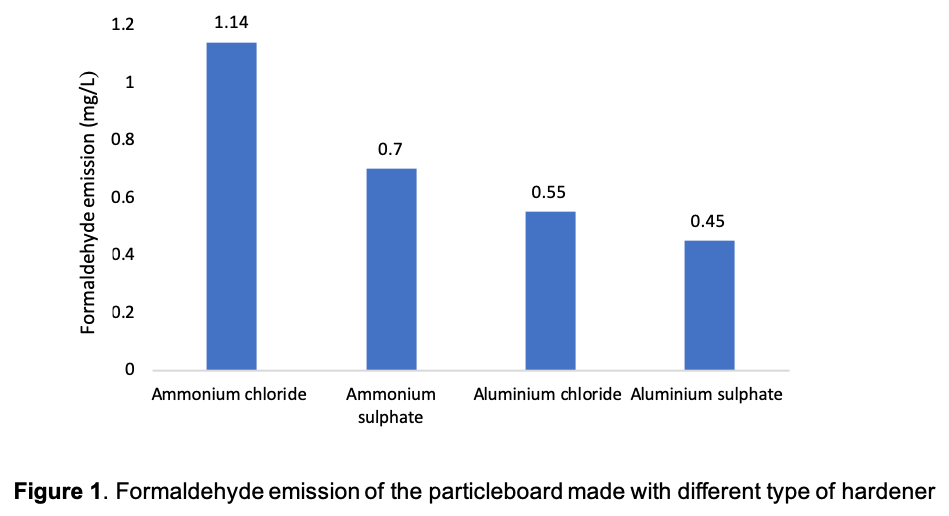Addition of ammonium and aluminium-based hardeners into urea formaldehyde resin and its effects on the properties and formaldehyde emission of the resultant particleboard
Urea formaldehyde (UF) resin is the most prevalently used binding agent in wood-based panels industry due to its cheap cost. However, one of the drawbacks of the UF resin is its continuous emittance of formaldehyde which is detrimental to users’ health. Application of formaldehyde scavenger or formaldehyde catcher is a conventional way to reduce the formaldehyde emission from wood or wood-based products. One of the methods to reduce formaldehyde emission is to modify the chemistry of urea formaldehyde resins by using other ammonium salts as cure catalysts or hardener, instead of latent ammonium chloride. Curing agents, also called hardener or catalyst are chemical substances added to the UF resin to speed up polymerization. UF resins are acid catalyzed resin and therefore acidic environment is needed for it to cure. These chemicals are either acidic substance by themselves or can liberate acids when mixed with the adhesives. These hardeners are normally used for UF-resin curing, however, in excess, they can act as formaldehyde scavengers which react with free formaldehyde to form hexamine.
Salts of chloride, sulphate, phosphate, nitrate, fluoride and borate are among the most widely used hardener in the fabrication of particleboard. Non-ammoniacal salts such as aluminium and magnesium salts was also reported as potential hardener as well as formaldehyde scavengers for UF resin. The function of hardener is to react with the free formaldehyde or any uncombined free formaldehyde that presents in the UF resins, where the reaction releases acid, hexamine as a by-product and water. The amount and type of hardener used in the resin formulation have been found to have a significant influence on the formaldehyde release from the resin and the UF particleboard.
The objective of this study was to evaluate the effects of ammonium and aluminium-based hardeners addition to the UF resin properties and its effects on the particleboard fabricated from the resin. Properties such as thickness swelling, bending strength, internal bonding strength and formaldehyde emission of the particleboard were determined. Particleboard with targeted density of 650 kg/m3 was fabricated in this study. Four types of hardeners, namely ammonium chloride, ammonium sulphate, aluminium chloride and aluminium sulphate were added at a dosage of 1% based on the solid content of UF resin. UF resin with dosage of 8% were used in the production of particleboard. The particleboard was pressed in a hot press at 180 °C for 270 s under pressure of 4 MPa. The physical and mechanical properties as well as formaldehyde emission of the produced particleboard were evaluated according to the relevant standards.
Salts of chloride, sulphate, phosphate, nitrate, fluoride and borate are among the most widely used hardener in the fabrication of particleboard. Non-ammoniacal salts such as aluminium and magnesium salts was also reported as potential hardener as well as formaldehyde scavengers for UF resin. The function of hardener is to react with the free formaldehyde or any uncombined free formaldehyde that presents in the UF resins, where the reaction releases acid, hexamine as a by-product and water. The amount and type of hardener used in the resin formulation have been found to have a significant influence on the formaldehyde release from the resin and the UF particleboard.
The objective of this study was to evaluate the effects of ammonium and aluminium-based hardeners addition to the UF resin properties and its effects on the particleboard fabricated from the resin. Properties such as thickness swelling, bending strength, internal bonding strength and formaldehyde emission of the particleboard were determined. Particleboard with targeted density of 650 kg/m3 was fabricated in this study. Four types of hardeners, namely ammonium chloride, ammonium sulphate, aluminium chloride and aluminium sulphate were added at a dosage of 1% based on the solid content of UF resin. UF resin with dosage of 8% were used in the production of particleboard. The particleboard was pressed in a hot press at 180 °C for 270 s under pressure of 4 MPa. The physical and mechanical properties as well as formaldehyde emission of the produced particleboard were evaluated according to the relevant standards.

Table 1 displays the mechanical and physical properties of the particleboard made with different type of hardener. Generally, the properties of the particleboard made in the study are influenced by the type of hardener used. In term of thickness swelling, the lowest thickness swelling value of 28.01% was recorded in the samples made with ammonium sulphate while the highest TS value of 36.79% was observed in the sample made with aluminium chloride. Similar trend was observed in the water absorption where particleboard made from aluminium chloride-added UF resin resulted in the highest water absorption. As for mechanical properties, particleboard made from ammonium chloride displayed the highest modulus of rupture and modulus of elasticity compared to that of its counterpart. The lowest MOR and MOE was recorded in the samples made with aluminium chloride. As for internal bonding strength, the panels made with ammonium-based hardeners displayed higher internal bonding strength compared to that of panels made with aluminium-based hardeners.

Figure 1 exhibits the average formaldehyde emission (FE) from the particleboard made with different hardeners. Generally, particleboard made with aluminium-based hardener emits a relatively lower FE (0.45 mg/L to 0.55 mg/L) compared to that of ammonium-based hardener (0.7 mg/L to 1.14 mg/L). This might be due to the fact that aluminium-based hardener holds more free formaldehyde than ammonium-based hardener. As confirmed by FTIR spectra, the intensity of peak corresponding to methylene ether bridges reduced after addition of hardeners. Reduction in methylene ether bridges resulted in lesser emittance of formaldehyde. The lowest content of methylene ether bridges was recorded when aluminium sulphate was added into UF resin and had the lowest free formaldehyde correspondingly. However, despite its efficiency in formaldehyde emission reduction, physico-mechanical of the particleboard made with aluminium-based hardeners were adversely affected to a greater extent in comparison to the ammonium-based hardeners. The adverse effects of aluminium-based hardeners on particleboard might probably caused by its shorter gelation time. UF resin admixed with aluminium-based hardeners very short gelation time of 28-31 seconds, compared to 65-66 seconds that recorded in UF/ammonium-based hardener admixtures. As a result, the resin hardened very quickly during pressing and consequently inhibited an even spread of resin that help promoting good particle-particle bonding. Apart from that, relatively higher viscosity and higher acidity of the UF resin after admixed with aluminium-based hardeners is also the reasons that led to the inferior properties of the particleboards.
Based on the results of this study, ammonium-based hardeners are more suitable to be used in the manufacturing of particleboard. Among ammonium chloride and ammonium sulphate, ammonium sulphate is a more preferrable option. In most of the central and northern Europe countries, ammonium sulphate has replaced ammonium chloride as the latter imposed some environmental issues. The burning residue of UF-bonded particleboard containing ammonium chloride may form dioxins compounds which is a group of polyhalogenated organic compounds that are significant environmental pollutants. On the contrary, this compound is not found in UF-bonded particleboard hardened with ammonium sulphate.
Based on the results of this study, ammonium-based hardeners are more suitable to be used in the manufacturing of particleboard. Among ammonium chloride and ammonium sulphate, ammonium sulphate is a more preferrable option. In most of the central and northern Europe countries, ammonium sulphate has replaced ammonium chloride as the latter imposed some environmental issues. The burning residue of UF-bonded particleboard containing ammonium chloride may form dioxins compounds which is a group of polyhalogenated organic compounds that are significant environmental pollutants. On the contrary, this compound is not found in UF-bonded particleboard hardened with ammonium sulphate.

